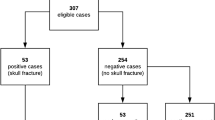Abstract
Background
Young children with suspected abusive head trauma often receive skull radiographs to evaluate for fractures as well as computed tomography (CT) of the head to assess for intracranial injury. Using a CT as the primary modality to evaluate both fracture and intracranial injury could reduce exposure to radiation without sacrificing performance.
Objective
To evaluate the sensitivity of CT head with (3-D) reconstruction compared to skull radiographs to identify skull fractures in children with suspected abusive head trauma.
Materials and methods
This was a retrospective (2013-2014) cross-sectional study of infants evaluated for abusive head trauma via both skull radiographs and CT with 3-D reconstruction. The reference standard was skull radiography. All studies were read by pediatric radiologists and neuroradiologists, with ten percent read by a second radiologist to evaluate for interobserver reliability.
Results
One hundred seventy-seven children (47% female; mean/median age: 5 months) were included. Sixty-two (35%) had skull fractures by radiography. CT with 3-D reconstruction was 97% sensitive (95% confidence interval [CI]: 89-100%) and 94% specific (CI: 87-97%) for skull fracture. There was no significant difference between plain radiographs and 3-D CT scan results (P-value = 0.18). Kappa was 1 (P-value <0.001) between radiologist readings of CTs and 0.77 (P = 0.001) for skull radiographs.
Conclusion
CT with 3-D reconstruction is equivalent to skull radiographs in identifying skull fractures. When a head CT is indicated, skull radiographs add little diagnostic value.



Similar content being viewed by others
References
Centers for Disease Control and Prevention (2016) Injury prevention and control: Rates of TBI-related emergency department visits by age group – United States, 2001-2010. http://www.cdc.gov/traumaticbraininjury/data/rates_ed_byage.html. Accessed 26 Oct 2015
Kleinman PK (2015) Skeletal imaging strategies. In: Kleinman PK (ed) Diagnostic imaging of child abuse, 3rd edn. Cambridge University Press, United Kingdom, pp 324–332
Kemp AM, Butler A, Morris S et al (2006) Which radiological investigations should be performed to identify fractures in suspected child abuse? Clin Radiol 61:723–736
Bajaj M, Offiah AC (2015) Imaging in suspected child abuse: necessity or radiation hazard? Arch Dis Child 100:1163–1168
Hackney DB (1991) Skull radiography in the evaluation of acute head trauma: a survey of current practice. Radiology 181:711–714
Lloyd DA, Carty H, Patterson M et al (1997) Predictive value of skull radiography for intracranial injury in children with blunt head injury. Lancet 349:821–824
Meyer JS, Gunderman R, Coley BD et al (2011) ACR appropriateness criteria on suspected physical abuse-child. J Am Coll Radiol 8:87–94
Chawla H, Yadav RK, Griwan MS et al (2015) Sensitivity and specificity of CT scan in revealing skull fracture in medico-legal head injury victims. Australas Med J 8:235–238
Chawla H, Malhotra R, Yadav RK et al (2015) Diagnostic utility of conventional radiography in head injury. J Clin Diagn Res 9:TC13–TC15
Sanchez T, Stewart D, Walvick M et al (2010) Skull fracture vs. accessory sutures: how can we tell the difference? Emerg Radiol 17:413–418
Kim Y, Cheong J, Yoon SH (2012) Clinical comparison of the predictive value of the simple skull x-ray and 3 dimensional computed tomography for skull fractures of children. J Korean Neurosurg Soc 52:528–533
Kleinman PK, Coats B, Silvera VM (2015) Abusive head trauma: scalp, subscalp, cranium. In: Kleinman PK (ed) Diagnostic imaging of child abuse, 3rd edn. Cambridge University Press, United Kingdom, pp 357–388
Parisi MT, Wiester RT, Done SL et al (2015) Three-dimensional computed tomography skull reconstructions as an aid to child abuse evaluations. Pediatr Emerg Care 31:779–786
Morrison J, Masse B, Oellet P et al (2013) Four-film X-ray series is more sensitive than 2-film for diagnosis of skull fractures in children. Pediatr Emerg Care 29:1189–1193
Chung S, Schamban N, Wypij D et al (2004) Skull radiograph interpretation of children younger than two years: how good are pediatric emergency physicians? Ann Emerg Med 43:718–722
Orman G, Wagner MW, Seeburg D et al (2015) Pediatric skull fracture diagnosis: should 3D CT reconstructions be added as routine imaging? J Neurosurg Pediatr 16:426–431
American Nuclear Society (2016) Radiation dose chart. http://www.ans.org/pi/resources/dosechart/msv.php. Accessed 27 May 2016
Slovis TL, Strouse PJ, Strauss KJ (2015) Radiation exposure in imaging of suspected child abuse: benefits versus risks. J Pediatr 167:963–968
Berger RP, Panigrahy A, Gottschalk S et al (2016) Effective radiation dose in a skeletal survey performed for suspected child abuse. J Pediatr 171:310–312
McCollough C, Cody D, Edyvean S et al (2008) The measurement, reporting, and management of radiation dose in CT. Report of AAPM Task Group 23. 23:1–28
Hart D, Jones DG, Wall BF (1996) NRPB-R279 coefficients for estimating effective doses from paediatric X-ray examinations. National Radiological Protection Board, Great Britain
International Committee on Radiation Protection (1991) 1990 Recommendations of the International Commission on Radiological Protection. ICRP Publication 60; Ann. ICRP 21:1-3. Pergamon Press, Oxford
Lantz CA, Nebenzahl E (1996) Behavior and interpretation of the kappa statistic: resolution of the two paradoxes. J Clin Epidemiol 49:431–434
Prabhu SP, Newton AW, Perez-Rossello JM et al (2013) Three-dimensional skull models as a problem-solving tool in suspected child abuse. Pediatr Radiol 43:575–581
Dundamadappa SK, Thangasmy S, Resteghini N et al (2015) Skull fractures in pediatric patients on computerized tomogram: comparison between routing bone window images and 3D volume-rendered images. Emerg Radiol 22:367–372
Wood JN, Feudtner C, Medina SP et al (2012) Variation in occult injury screening for children with suspected abuse in selected US children’s hospitals. Pediatrics 130:853–860
Meyer JS, Gunderman R, Coley BD et al (2011) Expert panel on pediatric imaging: ACR appropriateness criteria for suspected physical abuse – child. J Am Coll Radiol 8:87–94
Flaherty EG, Perez-Rosello JM, Levine MA et al (2014) Evaluating children with fractures for child physical abuse. Pediatrics 133:e477–e489
Author information
Authors and Affiliations
Corresponding author
Ethics declarations
Conflicts of interest
None
Rights and permissions
About this article
Cite this article
Culotta, P.A., Crowe, J.E., Tran, QA. et al. Performance of computed tomography of the head to evaluate for skull fractures in infants with suspected non-accidental trauma. Pediatr Radiol 47, 74–81 (2017). https://doi.org/10.1007/s00247-016-3707-7
Received:
Revised:
Accepted:
Published:
Issue Date:
DOI: https://doi.org/10.1007/s00247-016-3707-7




